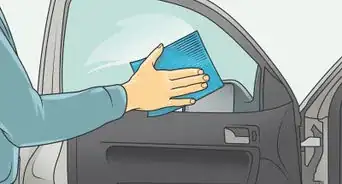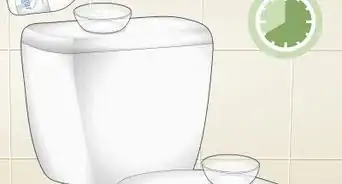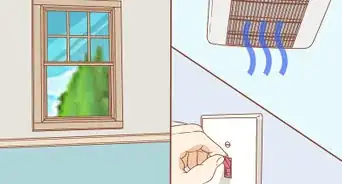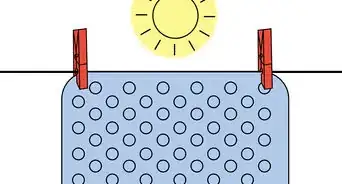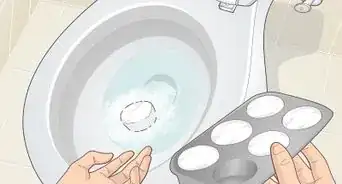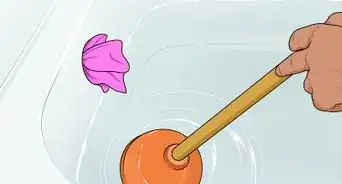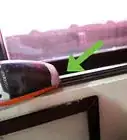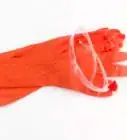This article was co-authored by Michelle Driscoll, MPH. Michelle Driscoll is the Owner of Mulberry Maids, which is based in Fort Collins, Colorado. With five years of experience, her business specializes in cleaning homes and small offices. She holds a Masters in Public Health from the Colorado School of Public Health. Additionally, Mulberry Maids has an A+ rating from the Better Business Bureau.
wikiHow marks an article as reader-approved once it receives enough positive feedback. This article has 33 testimonials from our readers, earning it our reader-approved status.
This article has been viewed 1,446,104 times.
Hard water spots are caused by minerals like calcium and magnesium in your water. When a surface gets wet, the water evaporates but leaves the mineral deposits behind. Sprinklers, car washes, and showers can all cause hard water spots to form on glass. Chemically, these deposits are alkali, so they require an acid to remove them. With a few household ingredients, you can remove and prevent further mineral deposits.
Steps
Using a Vinegar Solution
-
1Fill a squirt bottle with half water and half vinegar. The best vinegar to use is plain white distilled vinegar, which is inexpensive and effective.[1] A higher concentration of vinegar may be even more effective, so adjust the vinegar to water ratio based on the severity of the water spots.
-
2Spray the vinegar solution on the glass. Spray the solution on the glass, being sure to fully saturate any stubborn water spots or areas of concentrated buildup. Allow the vinegar to soak, and reapply a couple of times for particularly dirty areas.Advertisement
-
3Saturate a towel with the vinegar solution. Soak a rough towel in vinegar and water, and spread it over the sprayed area of glass. You can allow the towel to sit over the area so that the vinegar can soak in thoroughly.
-
4Scrub the glass lightly with the towel. Use your rough, soaked towel to scrub the glass. You should not have to scrub hard. The bumps on the towel should act as an abrasive to help remove the spots and allow the vinegar to penetrate the mineral build-up.
-
5Allow the vinegar solution to sit. The worse the stains are, the longer the vinegar will need to do its work. Let the vinegar soak in, and reapply if it seems to be drying out.[2]
-
6Remove the vinegar solution with a dry towel or squeegee. You may want to spray the area once more with your vinegar solution or plain water, then towel off with a clean, dry towel (or paper towel) or use a squeegee to remove the water. Be sure you do not allow the vinegar solution or water to dry on the surface of the glass, as this will continue to leave more spots.
Using Other Natural Products
-
1Use lemon juice instead of vinegar. Lemon juice has the same acidic properties as vinegar, and can be equally as effective. Fresh lemon usually works better than bottled lemon juice.
- Try rolling the lemon on a hard surface with some pressure before cutting it open. This will make the lemon easier to juice.
- Squeeze the juice out of a lemon and place in a spray bottle with water or use a towel to apply the lemon juice to the glass.
- Alternatively, you can use the lemon itself on the surface of the glass. Just cut the lemon in half and rub the open area on the glass with a fair amount of pressure.
- Allow the lemon to soak in, then remove from the glass using water or a traditional glass cleaner.
-
2Try lemon or orange essential oil. Essential oils are becoming increasingly popular due to their rumored health and cleaning benefits. Citrus-based essential oils such as lemon and orange may remove hard water deposits. This has an added benefit as well: the oil tends to serve as a water repellant and may prevent future spot buildups.
- Place several drops of the oil in water, and use a sponge or a towel to apply the solution to the glass.
- Allow to soak, then scrub lightly with the towel or sponge.
- Remove from the glass using water or a traditional glass cleaner.
-
3Apply white toothpaste to the area. As strange as this may sound, toothpaste is made to remove build-up, so it works fairly well on hard water spots.
- Water down the toothpaste with some water so that it spreads more easily and so that you can use less toothpaste.
- Apply the paste to the glass and allow to sit.
- Scrub lightly with a brush, a towel, or a sponge.
- Wash the paste away from the glass with water.
- Clean the glass with water or a traditional glass cleaner, but be sure to dry it thoroughly so that the water spots do not re-form.
-
4Make a paste of baking soda and vinegar. The paste will bubble when you combine the two. You can wait for the bubbling to subside or you can apply the still-bubbling paste directly onto the glass. Do not combine vinegar and baking soda in a closed container, as the resulting gas expansion may cause the lid to forcibly fly off.
- Apply the paste to the glass and allow to sit.[3]
- Scrub lightly with a brush, a towel, or a sponge.
- Wash the paste away from the glass with water.
- Clean the glass with water or a traditional glass cleaner, but be sure to dry it thoroughly so that the water spots do not re-form.
Using Abrasive Cleaners
-
1Find a powdered abrasive cleaner. Some abrasive cleaners are Comet, Barkeeper’s friend, or simple baking soda.[4] These are all powdered cleaners that can be sprinkled on a surface area.
-
2Wet the surface of the glass. It is easiest to wet the glass first, then apply the powder to it. This way, the powder will stick to the surface of the glass. The water and the abrasive will work together to make a sort of cleaning paste.
- For extra cleaning power, use straight vinegar or a 50/50 mixture of vinegar and water to wet the glass.
-
3Apply the powdered cleaner to the glass. Many purpose-made powder cleaners have multiple holes in the top that facilitate sprinkling. If yours doesn’t, or if you’re using baking soda, you could try putting the powder in a small sifter and sprinkling it on the surface with that.
-
4Use some “elbow grease.” The major benefit of the abrasive cleaners is the micro-scrubbing action provided by the granules of the cleaner.[5] In order for these granules to work, you will need to apply some vigorous scrubbing. Think of it as a double benefit: cleaning and a workout at one time!
-
5Rinse the product away with water. While some cleaning products can be left on the glass, an abrasive cleaner is likely to leave a residue since it isn’t designed specifically as a glass cleaner. Thoroughly rinsing the cleaner away with water, then cleaning the glass with a traditional glass cleaner is the best way to ensure that the abrasive cleaner does not leave any residue.
-
6Dry the glass. After you rinse away the cleaner and clean the glass with water or glass cleaner, be sure that you dry the surface thoroughly to prevent additional water spots.
-
7Use a fine-grade abrasive scrubber. An alternate approach to using an abrasive cleaner is to use a fine-grade abrasive scrubber. Look for one that is marked “0000” to ensure that it will not damage your glass. The scrubber essentially works like very fine sandpaper to remove stains and build-up from the glass. Some popular abrasive scrubbers are steel wool, rough green scrub sponges, and a product known as a magic eraser, which is a very fine sponge.
Using Cleaning Products
-
1Find a product made to remove hard water stain buildup. There are products that are specifically designed to remove hard-water spots from glass and other surfaces. You may want to try other household products first, as buying several different cleaning products for one cleaning problem can be costly. Here are a few specific products that may help with hard water spots:
- CLR
- Barkeeper’s Friend
- Kaboom
- Lime-away
-
2Apply the product according to the directions on the packaging. Most products require being sprayed on or applied using a sponge or towel. Most products will recommend that you allow them to sit and soak in to saturate the surface of the cleaning area.
- Some products suggest wiping them on and off, but not scrubbing them because scrubbing can lead to unwanted splatter.[6]
- It’s always best to test a small portion of the surface to be sure that a product will not damage it.
- Be sure to take care to keep the product only on the glass you are cleaning: the cleaner may damage adjacent walls, window sills, tile, flooring, or car paint.
-
3Wear some protective gear if necessary. Many cleaners are caustic and can be damaging to humans or animals. Be sure to wear gloves and protective eyewear such as goggles if necessary.
- Wash your hands immediately after contacting any cleaner, and never put your hands to your mouth, nose, or eyes immediately after contact with cleaners.
- Many cleaners suggest using in a well-ventilated area to avoid any bodily harm due to fumes from the product.
- Be sure to read warning labels on the product carefully.
-
4Clean the area with water or a vinegar solution. After using a cleaning product, you may want to clean the glass with a water or vinegar solution to remove any residue of the cleaner. Be sure to dry the glass thoroughly.
-
5Store the products safely. Cleaning products should always be stored outside of the reach of children and pets, with the lid securely in place and any spilled cleaner wiped away from the outside of the bottle. On a high shelf behind a door with a childproof latch on it is ideal.
Preventing Water Stains
-
1Treat water spots quickly. If hard water spots are treated in the beginning of their formation, they will be less stubborn and easier to remove. Simply spraying spots with a vinegar solution once a week or so, as they begin to form, may be adequate.
-
2Remove any resting water. Prevention is the best way to deal with hard water spots. Not allowing water to rest on and evaporate from surfaces can be the key to preventing the spots from forming in the first place.[7]
- Wipe the wet glass down with a dry towel if you see water on it.
- Use a squeegee to remove standing water from glass. This will keep your glass looking clean and clear.[8]
-
3Keep your windows dry. The easiest way to avoid water spots is to prevent your glass from getting wet to begin with. If you are dealing with water spots on car windows, try parking your car in a covered area, such as in your garage. Installing blinds or curtains may keep the water off of windows near kitchen or bathroom sinks.
-
4Treat the glass with a water repellant. A product that repels water, such as an oil-based cleaner or a product such as rain-x, may help spots from forming on your glass.[9] Do not use a product on car windows unless they are specifically made to treat car windows and will not interfere with visibility in wet or dry conditions.
Community Q&A
-
QuestionHow can I prevent mold from forming in the corners of the shower?
 Community AnswerYou can put the top of a spray bottle onto a bottle of peroxide and spray any spots that need it. Usually one application will take care of the mold, but stubborn mold might require several applications. It is non-toxic and won't hurt kids, pets, or plumbing.
Community AnswerYou can put the top of a spray bottle onto a bottle of peroxide and spray any spots that need it. Usually one application will take care of the mold, but stubborn mold might require several applications. It is non-toxic and won't hurt kids, pets, or plumbing. -
QuestionThe window cleaner I use is leaving spots. Any ideas?
 Community AnswerSome window cleaners are not good quality and leave residue or spots.Try a different window cleaner such as Windex, or use a light solution of distilled vinegar in water to finish off the cleaning. Dry the surface off completely with a soft, clean, lint-free cloth at the end.
Community AnswerSome window cleaners are not good quality and leave residue or spots.Try a different window cleaner such as Windex, or use a light solution of distilled vinegar in water to finish off the cleaning. Dry the surface off completely with a soft, clean, lint-free cloth at the end. -
QuestionI have a Honda with hard water stains and I've tried everything, vinegar, lemon, etc. What do I do?
 McKenna DouglasCommunity AnswerTry using a solution of Windex mixed with baking soda and vinegar. It sounds strange, but it worked for me.
McKenna DouglasCommunity AnswerTry using a solution of Windex mixed with baking soda and vinegar. It sounds strange, but it worked for me.
References
- ↑ http://www.newsday.com/lifestyle/home-and-garden/homework-how-to-remove-hard-water-stains-1.9507569
- ↑ http://www.newsday.com/lifestyle/home-and-garden/homework-how-to-remove-hard-water-stains-1.9507569
- ↑ http://www.housecleaningcentral.com/en/cleaning-tips/stain-removal/hard-water.html
- ↑ http://www.housecleaningcentral.com/en/cleaning-tips/stain-removal/hard-water.html
- ↑ http://www.housecleaningcentral.com/en/cleaning-tips/stain-removal/hard-water.html
- ↑ http://www.housecleaningcentral.com/en/cleaning-tips/stain-removal/hard-water.html
- ↑ http://www.newsday.com/lifestyle/home-and-garden/homework-how-to-remove-hard-water-stains-1.9507569
- ↑ http://www.housecleaningcentral.com/en/cleaning-tips/stain-removal/hard-water.html
- ↑ http://www.housecleaningcentral.com/en/cleaning-tips/stain-removal/hard-water.html
About This Article
For a natural and effective way to get hard water spots off of windows, mix up equal parts of water and white distilled vinegar in a squirt bottle. Spray the solution directly onto the glass, focusing on any areas with stubborn water spots. Next, soak a rough towel or washcloth in the same solution and lightly scrub the glass with it. Let the solution sit on the glass for several minutes—the more severe the stains, the longer it will need to soak. Spray the area one more time with plain water to rinse the vinegar away, then wipe the glass dry with a squeegee or a clean, lint-free towel or paper towel. If you’d rather not use vinegar, try an alternative such as lemon juice, toothpaste, or a commercial glass cleaner. To prevent new spots from forming, wipe your windows dry any time they get wet. You can also try treating the glass with an oil-based water repellant cleaner. If you want to learn how to prevent getting hard water spots on your window, keep reading the article!

